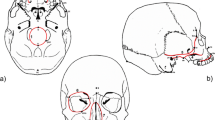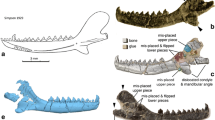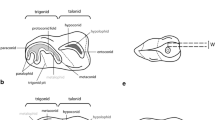Abstract
Dental wear is a function of age-at-death in human skeletal populations. However, discrete scoring proxies of dentine exposure areas have shown to largely depend on dietary life-history and cultural practices. In addition, dental wear greatly limits research on dental morphological variability since unworn teeth are scarce in osteo-archaeological repositories. Age at death is seldom known, and actual trends in dental crown loss are generally assumed to be age-dependent. We applied three-dimensional (3D) dental crown continuous metrics (geometric morphometrics and topographic shape descriptors) to explore the association of first and second permanent maxillary (UM1 and UM2) and mandibular (LM1 and LM2) molar wear with age in the Coimbra International Exchange known age-at-death skull collection. Results are indicative of significant regressions between the morphometric variables and age-at-death, though showing coefficients of determination of 1.4–23.9%. The precision percentages for determining age-at-death from dental crown shape varied from 31.8 to 45.3%, while a significant portion of the overall shape variation of the molar teeth studied could be attributed to anatomical traits independently of dental wear, since modern human populations display a great variability in cusp patterns and molar teeth relative size.


Similar content being viewed by others
Data Availability
Data are made available in the supplementary information files.
References
Adams, D. C., & Otarola-Castillo, E. (2013). Geomorph: an R package for the collection and analysis of geometric morphometric shape data. Methods in Ecology and Evolution, 4(4), 393–399. https://doi.org/10.1111/2041-210X.12035.
Alayan, I., Aldosary, M. S., & Santini, A. (2018). Validation of the efficacy of age assessment by the Brothwell tooth wear chart, using skulls of known age at death. Journal of Forensic Dental Sciences, 10(1), 18–21. https://doi.org/10.4103/jfo.jfds_15_17.
Benazzi, S., Bonetti, C., Cilli, E., & Gruppioni, G. (2008). Molar crown height: not always a reliable method for the evaluation of age-at-death. Journal of Archaeological Science, 35(8), 2371–2378. https://doi.org/10.1016/j.jas.2008.03.005.
Benazzi, S., Kullmer, O., Grosse, I. R., & Weber, G. W. (2011). Using occlusal wear information and finite element analysis to investigate stress distributions in human molars. Journal of Anatomy, 219(3), 259–272. https://doi.org/10.1111/j.1469-7580.2011.01396.x.
Berthaume, M. A., & Schroer, K. (2017). Extant ape dental topography and its implications for reconstructing the emergence of early Homo. Journal of Human Evolution, 112, 15–29. https://doi.org/10.1016/j.jhevol.2017.09.001.
Berthaume, M. A., Delezene, L. K., & Kupczik, K. (2018). Dental topography and the diet of Homo naledi. Journal of Human Evolution, 118, 14–26. https://doi.org/10.1016/j.jhevol.2018.02.006.
Bookstein, F. L. (1991). Morphometric tools for landmark data: geometry and biology. Cambridge: Cambridge University Press.
Boyer, D. M. (2008). Relief index of second mandibular molars is a correlate of diet among prosimian primates and other euarchontan mammals. Journal of Human Evolution, 55(6), 1118–1137. https://doi.org/10.1016/j.jhevol.2008.08.002.
Bunn, J. M., Boyer, D. M., Lipman, Y., St. Clair, E. M., Jernvall, J., & Daubechies, I. (2011). Comparing Dirichlet normal surface energy of tooth crowns, a new technique of molar shape quantification for dietary inference, with previous methods in isolation and in combination. American Journal of Physical Anthropology, 145(2), 247–261. https://doi.org/10.1002/ajpa.21489.
Cignoni, P., Callieri, M., Corsini, M., Dellepiane, M., Ganovelli, F., & Ranzuglia, G. (2008). MeshLab: an open-source mesh processing tool. In Sixth Eurographics Italian Chapter Conference (pp. 129–136) https://doi.org/10.2312/LocalChapterEvents/ItalChap/ItalianChapConf2008/129-136. Accessed 23 March 2020.
Clement, A. F., & Hillson, S. W. (2012). Intrapopulation variation in macro tooth wear patterns−a case study from Igloolik, Canada. American Journal of Physical Anthropology, 149(4), 517–524. https://doi.org/10.1002/ajpa.22153.
Correira, A. M. (1951). A alimentaçao do povo portugués. Lisboa: Instituto Nacional de Estadística.
Cunha, E., & Wasterlain, S. (2007). The Coimbra identified osteological collections. In G. Grupe & J. Peters (Eds.), Skeletal series and their socio-economic context, Documenta Archaeobiologiae (Vol. 5, pp. 23–33). Rahden/Westf: Verlag Marie Leidorf GmbH.
Dykes, S. J., & Pilbrow, V. C. (2019). A mathematical landmark-based method for measuring worn molars in hominoid systematics. PeerJ, 7, e6990. https://doi.org/10.7717/peerj.6990.
Evans, A. R. (2013). Shape descriptors as ecometrics in dental ecology. Hystrix, 24(1), 133–140. https://doi.org/10.4404/hystrix-24.1-6363.
Evans, A. R., Wilson, G. P., Fortelius, M., & Jernvall, J. (2007). High-level similarity of dentitions in carnivorans and rodents. Nature, 445(7123), 78–81. https://doi.org/10.1038/nature05433.
Fiorenza, L., Benazzi, S., Tausch, J., Kullmer, O., Bromage, T. G., & Schrenk, F. (2011). Molar macrowear reveals Neanderthal eco-geographical dietary variation. PLoS ONE, 6(3), e14769. https://doi.org/10.1371/journal.pone.0014769.
Fiorenza, L., Benazzi, S., Oxilia, G., & Kullmer, O. (2018). Functional relationship between dental macrowear and diet in Late Pleistocene and recent modern human populations. International Journal of Osteoarcaheology, 28(2), 153–161. https://doi.org/10.1002/oa.2642.
Geomagic User Guide. (2013). 3D system, Inc. www.geomagic.com.
Górka, K., Romero, A., & Pérez-Pérez, A. (2016). Dental-macrowear and diet of Tigara foragers from Point Hope, northern Alaska. Anthropologischer Anzeiger, 73(3), 257–264. https://doi.org/10.1127/anthranz/2016/0613.
Hammer, Ø., Harper, D., & Ryan, P. D. (2001). PAST: Paleontological Statistics software package for education and data analysis. Paleontologia Electronica, 4(1), 1–9.
Kaidonis, J. A., Ranjitkar, S., Lekkas, D., & Townsend, G. C. (2012). An anthropological perspective: another dimension to modern dental wear concepts. International Journal of Dentistry, 2012, 741405–741406. https://doi.org/10.1155/2012/741405.
Klingenberg, C. P. (2011). MorphoJ: an integrated software package for geometric morphometrics. Molecular Ecology Resources, 11(2), 353–357. https://doi.org/10.1111/j.1755-0998.2010.02924.x.
Larsen, C. S. (1997). Bioarchaeology: interpreting behavior from the human skeleton. Cambridge: Cambridge University Press.
M’Kirera, F., & Ungar, P. S. (2003). Occlusal relief changes with molar wear in Pan troglodytes troglodytes and Gorilla gorilla gorilla. American Journal of Primatology, 60(2), 31–41. https://doi.org/10.1002/ajp.10077.
Mays, S. (2002). The relationship between molar wear and age in an early 19th century archaeological human skeletal series of documented age at death. Journal of Archaeological Science, 29(8), 861–871. https://doi.org/10.1006/jasc.2001.0751.
Millard, A., & Gowland, R. (2002). A Bayesian approach to the estimation of age of humans from tooth development and wear. Archeologia e Calcolatori, 13, 197–210.
O'Higgins, P. (2000). The study of morphological variation in the hominid fossil record: biology, landmarks and geometry. Journal of Anatomy, 197(1), 103–120. https://doi.org/10.1046/j.1469-7580.2000.19710103.x.
Pampush, J. D., Winchester, J. M., Morse, P. E., Vining, A. Q., Boyer, D. M., & Kay, R. F. (2016a). Introducing molaR: a new R package for quantitative topographic analyses of teeth (and other topographic surfaces). Journal of Mammalian Evolution, 23(4), 397–412. https://doi.org/10.1007/s10914-016-9326-0.
Pampush, J. D., Spradley, J. P., Morse, P. E., Harrington, A. R., Allen, K. L., Boyer, D. M., & Kay, R. F. (2016b). Wear and its effects on dental topography measures in howling monkeys (Alouatta palliata). American Journal of Physical Anthropology, 161(4), 705–721. https://doi.org/10.1002/ajpa.23077.
Pampush, J. D., Spradley, J. P., Morse, P. E., Griffith, D., Gladman, J. T., Gonzales, L. A., & Kay, R. F. (2018). Adaptive wear-based changes in dental topography associated with atelid (Mammalia: Primates) diets. Biological Journal of the Linnean Society, 124(4), 584–606. https://doi.org/10.1093/biolinnean/bly069.
Polychronis, G., Christou, P., Mavragani, M., & Halazonetis, D. J. (2013). Geometric morphometric 3D shape analysis and covariation of human mandibular and maxillary first molars. American Journal of Physical Anthropology, 152(2), 186–196. https://doi.org/10.1002/ajpa.22340.
Richards, L. C., & Brown, T. (1981). Dental attrition and age relationship in Australian Aboriginals. Archeology in Oceania, 16(2), 94–98.
Rocha, M. A. (1995). Les collections ostéologiques humaines identifiées du Musée Anthropologique de l’Université de Coimbra. Antropologia Portuguesa, 13, 7–38.
Romero, A., Ramírez-Rozzi, F. V., Cuesta-Torralvo, E., & Pérez-Pérez, A. (2019). Age-related tooth wear in African rainforest hunter-gatherers. American Journal of Physical Anthropology, 170(4), 622–628. https://doi.org/10.1002/ajpa.23934.
Santos, A.L.C. 2000. A skeletal picture of tuberculosis: macroscopic, radiological, biomolecular, and historical evidence from the Coimbra identified skeletal collection. Unpublished PhD Thesis, Universidade de Coimbra.
Schmidt, C. W., & Watson, J. T. (2020). Dental wear in evolutionary and biocultural contexts. Cambridge: Academic Press.
Scott, E. C. (1979). Dental Wear Scoring Technique. American Journal of Physical Anthropology, 51(2), 213–218. https://doi.org/10.1002/ajpa.1330510208.
Scott, R. G., & Irish, J. D. (2017). Human tooth crown and root morphology. Cambridge: Cambridge University Press.
Singleton, M. (2002). Patterns of cranial shape variation in the Papionini (Primates: Cercopithecinae). Journal of Human Evolution, 42(5), 547–578. https://doi.org/10.1006/jhev.2001.0539.
Slice D. E. (2007). Geometric Morphometrics. Annual Review of Anthropology, 36(1), 261–281. https://doi.org/10.1146/annurev.anthro.34.081804.120613.
Smith, B. H. (1984). Patterns of molar wear in hunter – gatherers and agriculturalists. American Journal of Physical Anthropology, 63(1), 39–56. https://doi.org/10.1002/ajpa.1330630107.
Spradley, J. P., Pampush, J. D., Morse, P. E., & Kay, R. F. (2017). Smooth operator: the effects of differ-rent 3D mesh retriangulation protocols on the computation of Dirichlet normal energy. American Journal of Physical Anthropology, 163(1), 94–109. https://doi.org/10.1002/ajpa.23188.
Ulhaas, L., Kullmer, O., Schrenk, F., & Henke, W. (2004). A new 3-d approach to determine functional morphology of cercopithecoid molars. Annals of Anatomy, 186(5-6), 487–493. https://doi.org/10.1016/S0940-9602(04)80090-6.
Veneziano, A., Landi, F., & Profico, A. (2018). Surface smoothing, decimation, and their effects on 3D biological specimens. American Journal of Physical Anthropology, 166(2), 473–480. https://doi.org/10.1002/ajpa.23431.
Walker, P. L., Dean, G., & Shapiro, P. (1991). Estimating age from tooth wear in archaeological populations. In M. A. Kelley & C. S. Larsen (Eds.), Advances in Dental Anthropology. New York: Wiley-Liss.
Webster, M., & Sheets, H. D. (2010). A practical introduction to landmark-based geometric morphometrics. In J. Alroy & G. Hunt (Eds.), Quantitative Methods in Paleobiology Paleontological Society Papers (pp. 163–188). Cambridge: Cambridge University Press.
Weisensee, K. E., & Jantz, R. L. (2011). Secular changes in craniofacial morphology of the Portuguese using geometric morphometrics. American Journal of Physical Anthropology, 145(4), 548–559. https://doi.org/10.1002/ajpa.21531.
Winchester, J. M. (2016). MorphoTester: an open source application for morphological topographic analysis. PLoS ONE, 11(2), e0147649. https://doi.org/10.1371/journal.pone.0147649.
Winchester, J. M., Boyer, D. M., St. Clair, E. M., Gosselin-Ildari, A. D., Cooke, S. B., & Ledogar, J. A. (2014). Dental topography of platyrrhines and prosimians: Convergence and contrasts. American Journal of Physical Anthropology, 153(1), 29–44. https://doi.org/10.1002/ajpa.22398.
Yong, R., Ranjitkar, S., Lekkas, D., Halazonetis, D., Evans, A., Brook, A., & Townsend, G. (2018). Three-dimensional (3D) geometric morphometric analysis of human premolars to assess sexual dimorphism and biological ancestry in Australian populations. American Journal of Physical Anthropology, 166(2), 373–385. https://doi.org/10.1002/ajpa.23438.
Zelditch, M. L., Swiderski, D. L., Sheets, H. D., & Fink, W. L. (2004). Geometric morphometrics for biologists: a primer. New York: Academic Press.
Funding
This research was funded by the Spanish Ministerio de Economía y Competitividad grant number CGL2014-52611-C2-1-P.
Author information
Authors and Affiliations
Contributions
The project was funded to APP. The dental molds and casts were made by ECT and DP. Access to the skeletal collection was provided by CU. Meshes were processed by ECT, DP, and YA. The interobserver measurement error test was made by ECT, DP, and APP. Geometric morphometrics and topographic data were collected by ECT and DP. Statistical analyses were made by APP, ECT, and AR. Paper drafts and reviews were made by APP, AR, LMM, and ECT. We thank Eugénia Cunha for assistance in the Coimbra International Exchange collection at the University of Coimbra.
Corresponding author
Ethics declarations
Conflict of Interest
The authors declare that they have no conflicts of interest.
Code Availability
Only free, open-access or licensed software codes were used.
Additional information
Publisher’s Note
Springer Nature remains neutral with regard to jurisdictional claims in published maps and institutional affiliations.
Rights and permissions
About this article
Cite this article
Cuesta-Torralvo, E., Pacheco, D., Martínez, L.M. et al. Three-Dimensional Proxies to Dental Wear Characterization in a Known Age-at-Death Skeletal Collection. J Archaeol Method Theory 28, 1261–1275 (2021). https://doi.org/10.1007/s10816-020-09496-1
Accepted:
Published:
Issue Date:
DOI: https://doi.org/10.1007/s10816-020-09496-1




